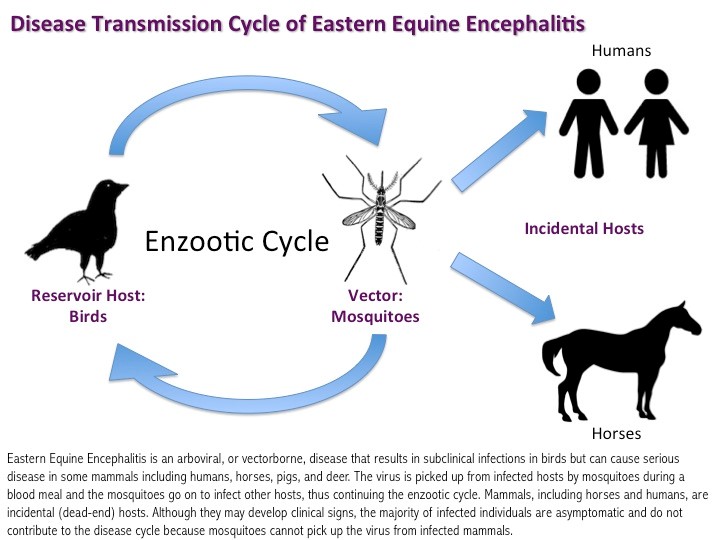Eastern Equine Encephalitis virus (EEE) is an arbovirus which is a mosquito-borne virus. It circulates between bird reservoir hosts and mosquitoes. Most infected animals and people have inapparent infections, but EEE can cause mortality in some species of birds such as pigeons, pheasants, and emus.
Mammals are incidental hosts and humans and horses are the most common mammals to develop clinical disease. EEE has also caused illness in pigs, rodents, and white-tailed deer.
The majority of wild birds infected with the virus will exhibit no clinical signs.
Transmission occurs from the bite of an infected mosquito. Mosquitos become infected with EEE when they take a blood meal from a bird that is carrying the virus. Mosquitos then transmit the virus to other birds during subsequent blood meals, continuing the cycle. EEE is not transmitted by direct contact.
The virus can be diagnosed by laboratory testing of blood, tissues, or cerebrospinal fluid.
There is no cure for EEE and supportive care is the only treatment for neuro-invasive (severe) EEE.
In order to prevent the spread of EEE, remove standing water in and around homes, this can help reduce mosquito larvae, because mosquitoes lay eggs in water. Vaccines are available for birds and horses.
Personal preventive measures include limiting skin exposure by wearing shoes, socks, long sleeves, and pants, especially during times when mosquitoes are most active like dusk. Exposed skin can be protected with mosquito repellent.
There have been five known fatal human cases of EEE in New York State between 1971 and 2011. Historically, human and animal cases have occurred in a limited geographic area centered around Oneida, Madison, Oswego and Onondaga Counties in Central New York. However, most counties do not conduct active surveillance for EEE or West Nile Virus. In 2013 positive mosquito pools and an infected horse were reported in Chautauqua County for the first time.
Horses that are infected may die suddenly with no clinical signs or may exhibit progressive neurologic deficits. These may include fever, depression, reduced appetite, weakness, loss of coordination, circling, and seizures. Blindness, excitability, irritability, and aggressiveness may also occur. Horses experience a high mortality rate at approximately 75%-90%. Horses who survive often have permanent nervous system damage. Vaccination of horses and susceptible birds is recommended in geographic areas where EEE occurs.
Most humans that contract EEE will be asymptomatic. Mild cases are characterized by abrupt onset of flu-like illness with symptoms that include fever, chills, and malaise. Systemic illness lasts about one to two weeks but patients generally recover. In the more severe form, signs include fever, headache, irritability, restlessness, drowsiness, anorexia, vomiting, diarrhea, seizures, and coma. About a third of all people with the severe form of EEE die from the disease. Patients who recover often suffer disabling long-term damage.
The Culiseta genus of mosquitoes feeds on birds. Mammals may become infected by a mosquito species that bites both birds and mammals, such as Aedes and Coquillettidia.
Humans and horses are most likely to develop clinical illness. Mammals are considered dead-end hosts because although they can become infected, the number of viral particles in the blood is not high enough to pass the virus on to new mosquitoes.
EEE cycle.jpg

A patient’s clinical signs and history, especially travel history, contribute to a preliminary diagnosis. Laboratory tests include ELISA for IgM antibodies, neutralization assays and PCR for virus on blood or tissue.
There is no vaccine available for humans, so preventative measures to reduce mosquito populations and mosquito bites are particularly important. There is an EEE vaccine available for horses. The American Association of Equine Practitioner (AAEP) lists the EEE vaccine in their core vaccination guidelines.
Measures such as mosquito vector control and limiting exposure to mosquito bites should be practiced. Eliminating the breeding habitat helps reduce mosquito populations. Areas of standing water include wheelbarrows, pool covers, birdbaths, gutters and any other place water can collect. Pool and pond water can be treated with mosquito dunks, which contain a natural bacterial product that kills mosquito larvae.
Mosquitoes should be prevented from entering the home through open windows and doors or broken screens. Local county health departments are responsible for general mosquito control measures in New York.
Mosquito surveillance by local health departments is voluntary. In those counties that conduct surveillance mosquito pools from traps are collected weekly during the summer. The New York State Department of Health’s Wadsworth Laboratory tests mosquitoes for multiple arboviral diseases. Cases of encephalitis and meningitis in humans are reported to state and federal agencies, and EEE is a nationally notifiable disease, which means it is reported to the Center for Disease Control.


